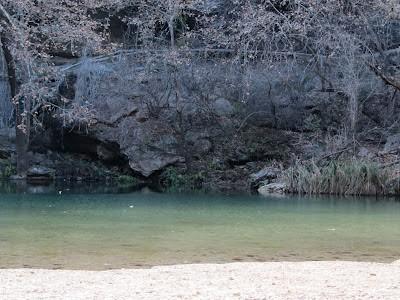Swimming Hole by Brad Gibson
Q: Practice and the seasons: Does your practice change with the seasons and if so how?
A: Where I live, there are seasons (though some people might argue differently), but rarely extremes of weather. But one summer day that was actually hot, I went to my regular Friday morning yoga class, expecting backbends because my teacher always teaches backbends the second class of the month. Our studio, though in a beautiful old building, had no insulation and very little climate control, with poor heating in the winter and no air conditioning in the summer, so it was unusually warm in the studio.The teacher opened the class with a little smile, saying, “Today we’re going to do some nice cooling backbends.” Everyone laughed, because, of course, backbends are typically not at cooling. But guess what. We did do backbends, but our teacher modified his typical sequence so we did a cooler practice of stretches, passive backbends, and the less effortful, active backbends, rather than a “hotter” practice of standing poses and very active backbends.That memory of that still makes me smile, but I bring it up today because I don’t necessarily change my practice with the seasons per se, but I’m definitely change my practice to fit the weather and the temperature in the space where I’m practicing.Today is a cold and rainy day in Berkeley, California and my house is a little bit drafty, so I would incline toward an active, heating practice rather than a passive cooling practice. Trying to do, for example, a restorative practice in a cold room is not only very challenging because you get colder and colder the longer you stay still, but it is also not very effective, because being cold stimulates your nervous system, alerting your body and mind that you may in danger. So it’s very difficult to relax. On the other hand, the active poses warm up both you and the room quite nicely.Likewise, being too hot is very stimulating for the same reasons; your nervous system warns your body and mind there may be danger. So when it’s hot, it’s a good time to do more passive and relaxing poses. Or, slowly work up to the active poses and take time to rest and cool down.Naturally you don’t want to do only active practices all winter and only passive practices all summer, but as my teacher did that day, you modify any sequence by adding more cooling poses or heating poses to accommodate the climate, both outdoors and indoor. For your convenience, I’ve categorized the general groups of poses into Heating and Cooling.Heating Poses:
- Sun Salutations
- Standing Poses
- Active backbends
- Headstand and arm balances
- Twists and abdominal strengtheners
- Restorative poses
- Reclined poses
- Forward bends
- Supported inverted poses
—Nina
Subscribe to YOGA FOR HEALTHY AGING by Email ° Follow Yoga for Healthy Aging on Facebook


